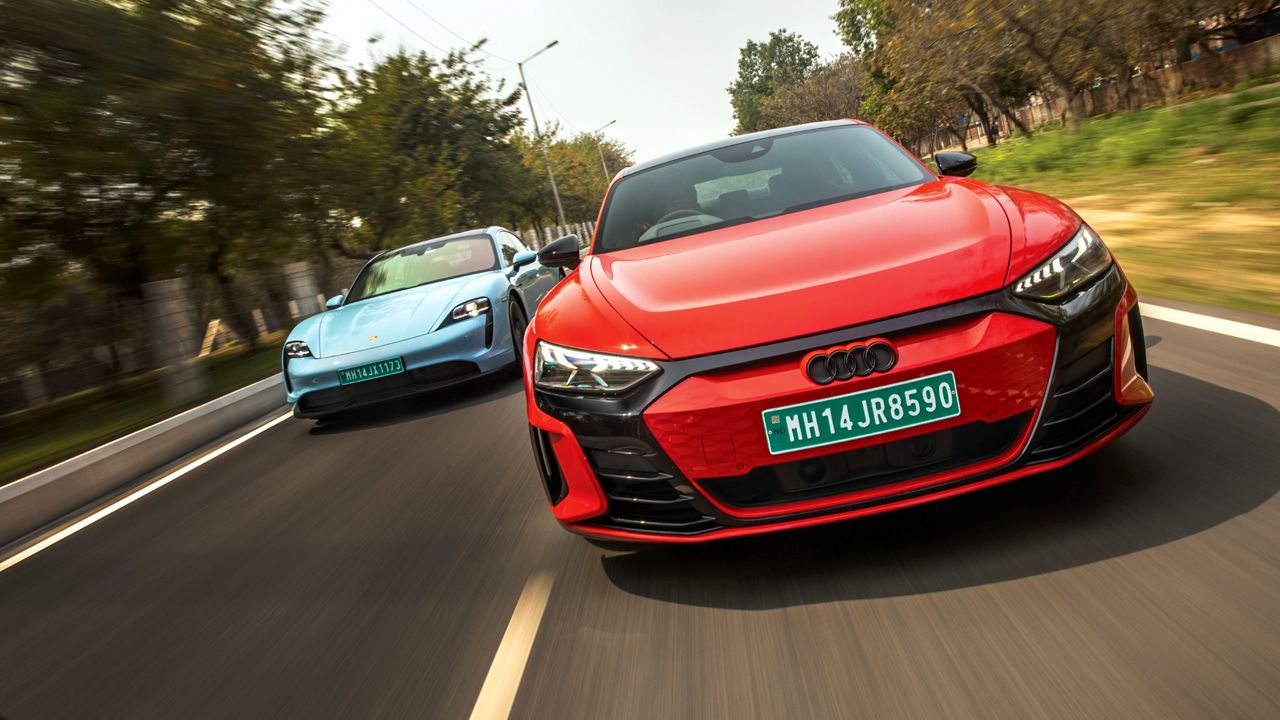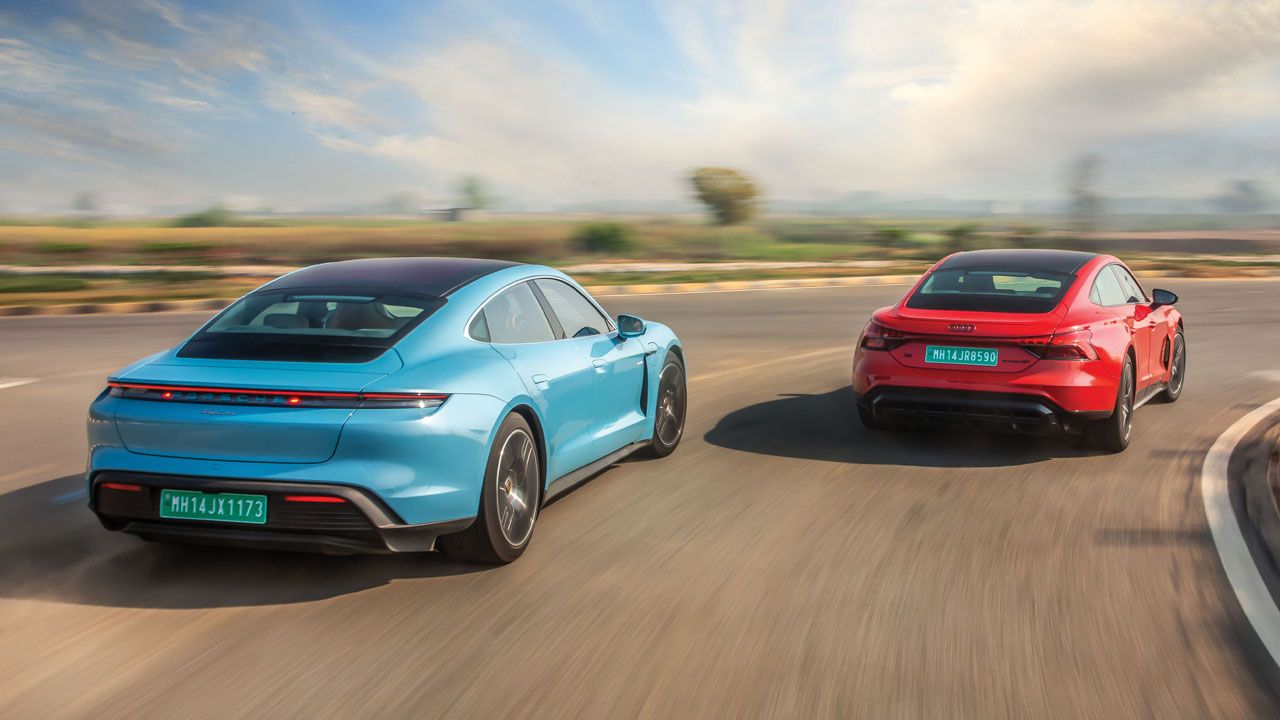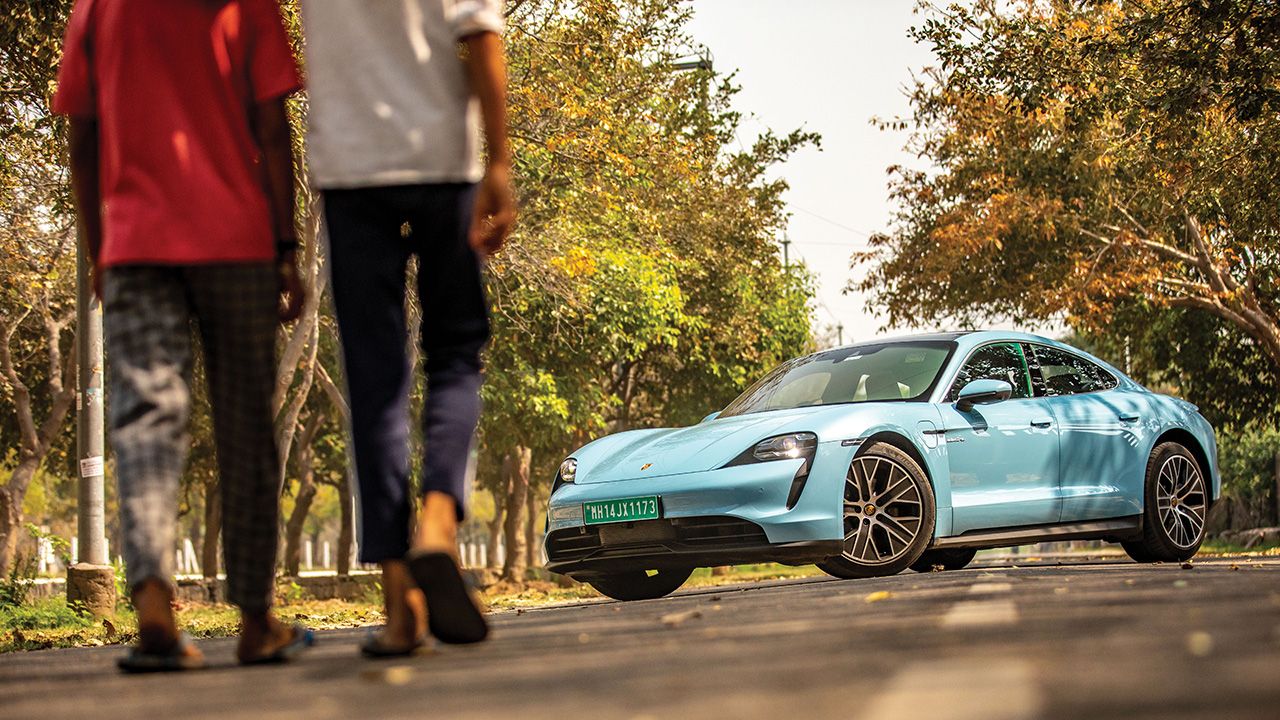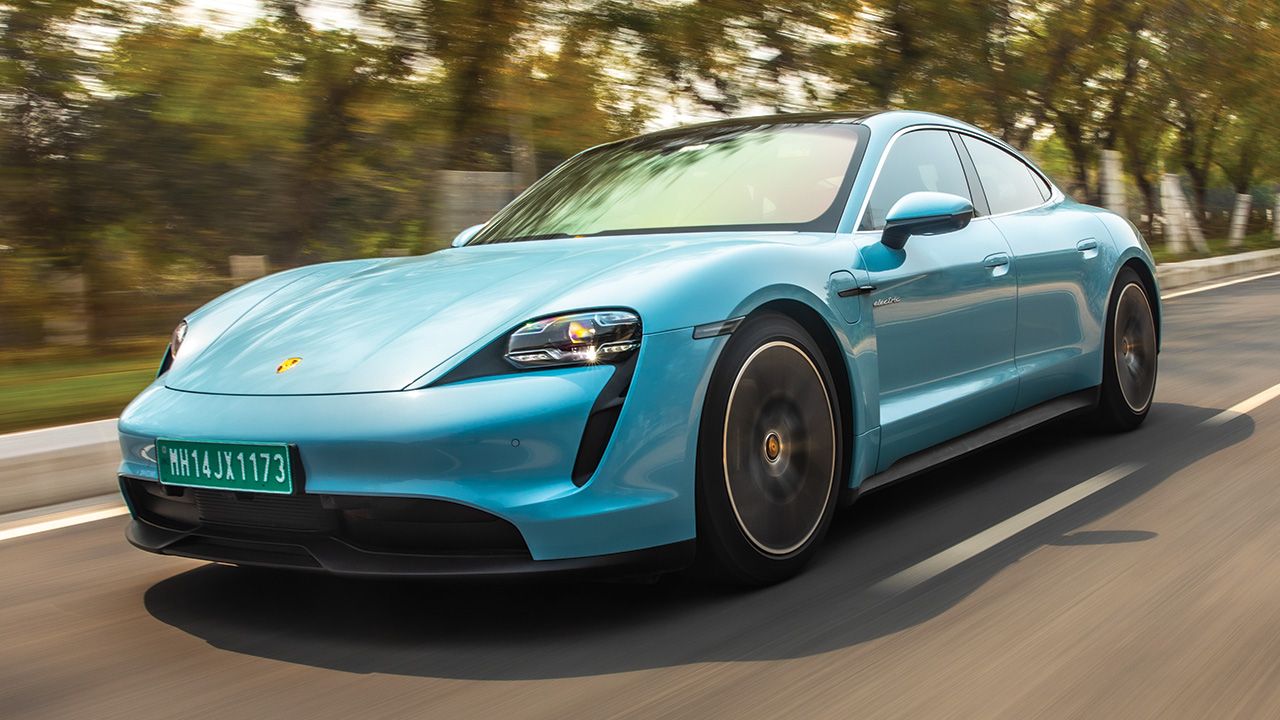The Porsche Taycan and Audi RS e-tron GT give us a glimpse into the future of performance cars. They’re bright and mind-numbingly fast, but are they capable of stirring a driver’s soul?
An unending global pandemic, cash-turning crypto, Boeings falling out of the sky, a simmering World War III, and electric cars pretending to be fun – well, you’ve got to say that the world has gone completely nuts in the past few years.
Now, while virology, finance, aviation, and politics are topics that are beyond our purview, you won’t find us shying away from our hot takes on EVs in this space. In fact, in this particular story, we’re turning up the heat by putting not one but two of the best performance electric cars (claimed, of course) in the world – the Porsche Taycan and Audi RS e-tron GT – to the test.
For the uninitiated, the Taycan and e-tron GT come with different badges and styling, but under the skin, they both share daddy Volkswagen’s J1 Performance EV architecture. However, these two EVs claim to offer totally different flavours of experience – something that we’d verify shortly in this very piece.
Another reason for bringing these two heavyweight EVs together is to see if these first-ever performance electrics from these two ‘legacy’ car brands are as good as they’re cracked up to be? So, get ready for the ride – it’s where the rubber meets the road!
High Voltage Drama: Porsche Taycan
If there’s a carmaker with a knack for kicking the laws of physics in the teeth, it’s Porsche. For over seven decades, it has been resiliently putting the engine in the ‘wrong’ place in the 911, and yet, as the whole world already knows for a while now, the nine-eleven is one of the finest, if not the finest sports cars of all time. And if you need more proof of Porsche’s engineering brilliance, just take a look at what it has done with the Cayenne and Macan – the way these high-riding vehicles from Stuttgart handle is enough to justify the use of the word ‘Sport’ in SUV.
You only have to twirl the steering wheel once to realise that the Taycan is a fully dialled-up sports car masquerading as a planet-saving EV
There’s no denying, then, that Porsche has a history of bending rules and pushing goalposts with each new product that it launches. But has the brand been able to maintain its immaculate reputation with its first-ever EV?
Starting with the exterior design, the Taycan doesn’t look extraordinary or outlandish. In fact, every crease and curve on its body reflects its deep Zuffenhausen roots. Even though we had the base Taycan on test here, there’s no telling it apart from its mightier siblings. It’s low, wide, and oozes typical Porsche flair, thanks to elements like a sloping bonnet with tear-drop-shaped air curtains and a 911-like meaty derriere.
Not only is the Taycan sleek but also quite slippery, in aerodynamic terms. With a Cd of 0.22, the Taycan has the best drag coefficient of all existing Porsche models. All in all, the Taycan is a stunner, especially in this Frozen Blue Metallic shade that you see here – it grabs eyeballs like anything.
Hop into the cabin, and it becomes even more evident that you’re in a Porsche. The driver’s seat is low and sporty, and your body fits in it like a hand in a glove. The visibility out of the cabin is brilliant, and the thin-rimmed and leather-wrapped steering wheel, with a rotary drive mode selector, is so 911-like. Where it differs from your regular 911s and Panameras, though, is in terms of gadgetry inside the cabin. The Taycan takes the game forward and how! The interior is a tech nerd’s wet dream, with one too many screens – the large 16.3-inch curved display is hands down one of the most advanced displays in any car at the moment.
The Taycan’s rear seats aren’t as spacious as those of the Panamera, but four people can travel together in comfort. That said, if you find yourself inside a Taycan, don’t let anyone push you out of the driver’s seat because it’s best enjoyed from behind the wheel!
You only have to twirl the steering wheel once to realise that the Taycan is a fully dialled-up sports car masquerading as a planet-saving EV. The steering is 911-good, which means that it drips with feedback and is incredibly sharp. Be it at low speeds in town or around high-speed corners on a racetrack, you’ll find the Taycan’s rack to be as communicative as your favourite talk-show host. It’s as if the car has the power to relay messages from all four wheels through separate channels. You know exactly what’s happening at all four corners all the time – it’s simply sensational.
Then there’s the handling, which is another no-compromise aspect of the Taycan. Given the fact that the Taycan tips the scales at over 2.1 tonnes, it shouldn’t take corners at ridiculous speeds as it does! Irrespective of how hard you push it, the Taycan will always go where you want it to, and with perfect precision. In simple words, the front end is just delightful! What’s more, since the base Taycan is rear-wheel drive – it comes with a single motor at the rear-axle – it’s a bit playful too.
In terms of performance, even in this base version, which gets a 79.2kWh battery pack and a single motor, developing a peak power of 402bhp (in Overboost), the Taycan shoots forward in a relentless manner. However, performance isn’t exactly neck-snapping as it takes a rather leisurely 5.4 seconds to do the 0 – 100km/h sprint. While not brutal, the acceleration is still strong enough to put some conventional performance saloons to shame.
If you want mind-shattering performance, you should obviously look at the mighty Turbo and Turbo S versions of the Taycan. Or, maybe check out the RS e-tron GT – albeit it’s a different kind of animal altogether.
The Live Wire: Audi RS e-tron GT
With 637bhp and 830Nm of torque, the RS e-tron GT is the most powerful road-going Audi ever, and it lives up to that claim with a staggering 0 – 100km/h time of just 3.3 seconds! Numbers and its claim to bragging rights aside, it’s the way it shoots forward that numbs your mind and senses. Let me tell you how.
You engage ‘Launch Control’, and the ‘Boost’ starts building as soon as you depress the brake and the throttle pedals together. Let go of the left foot, and, bam, you’ll find yourself ripping a hole in the space-time continuum! Saying that its acceleration is vicious will be quite an understatement, really. The manner in which the RS GT gains momentum with its launch control, you wonder if they should start calling it ‘Launch Assault’ instead! To get a sense of how it feels for those three seconds or so, imagine someone hammering the back of your head while you’re being stabbed in the chest with a dagger simultaneously. That’s exactly how it feels – the hammer here is the launch control, and the dagger is the g-forces your body is subjected to. I’ve never experienced this kind of savagery in any other car before. What’s even more sensational is that the performance never tapers off – the RS e-tron GT has a bottomless pool of power.
The manner in which the RS e-tron GT gains ground with its launch control, you wonder if they should start calling it ‘Launch Assault’ instead!
The RS e-tron shares the Taycan’s platform, but it’s quite evident that the final product was engineered in Ingolstadt. That’s because every aspect of the RS e-tron GT is quintessentially Audi. Be it its muscular haunches, aggressive stance, massive 20-inch wheels, or overall dramatic shape, the RS e-tron exhibits a more brat-like sassy attitude.
Step inside, and it’s a completely different story, for the RS GT’s cabin follows a more conservative and clinical approach. Mind you, the quality is as good as you’d expect from an Audi, and there are creature comforts aplenty, but the design and layout of the cabin aren’t revolutionary. Being an RS, it gets familiar sporty bits and bobs, such as stainless-steel pedals, body-hugging sports seats, RS badges, a piano-black brushed aluminium dashboard, and contrasting red stitching. It doesn’t, however, have a curved display like the Porsche though – instead, you get the same 12.3-inch virtual cockpit driver display that you find in other Audis. Even the 10.1-inch touchscreen infotainment system is the same as that of the other models in the family. What’s more, unlike the Taycan, which gives you access to every single menu and function through a screen, Audi has decided to go all sensible with physical switches for the air con.
Now, the Audi distances itself further from the Porsche in the driving department. You see, Porsche likes to market the Taycan as a fast four-door sportscar, but Audi pitches its offering as a grand tourer, which is what the GT in its name also means.
The first thing that you notice, as you step inside the Audi, is that it’s more oriented towards comfort. The Alcantara-wrapped steering wheel is thicker than that of the Taycan, and while the seating is low, it’s not as sporty as that of the Porsche. Get on the move, and the difference between Audi’s and Porsche’s approach becomes even more evident. The Audi’s steering wheel feels exactly the way it feels in any fast Audi – a bit inert but sharp and precise. It doesn’t also have the heft and firmness of the Porsche’s wheel, which also shows its orientation towards comfort.
Unlike the base Taycan, the RS e-tron GT is a full-fledged, fully-loaded performance version of Audi’s take on the J1 platform – it simply means that you get virtually everything under the sun. For starters, it gets a bigger 93.4kWh battery pack, and there are two motors – one on each axle – making it a quattro all-wheel drive. Consequently, the RS e-tron has loads and loads of grip – it sticks to the road like superglue. You’d think that compared to the Porsche, the Audi would be softer and less wieldy, but that’s hardly the case. Sure, if you drive it back to back with the Taycan, you’ll notice that it tends to understeer a bit, but then you also have to understand that it’s a much heavier car (2.4 tonnes) than the Porsche, and because it has an explosive drivetrain, you’ll find yourself approaching corners at much higher speeds than you would in the base Taycan. A more appropriate comparison would be with the Taycan Turbo, which has similar specs as the RS.
What impresses you, even more, is the RS e-tron GT’s ride quality. Despite being a heavyweight electric vehicle – a performance version at that – its ride quality is simply stellar, thanks to the beautifully calibrated air-suspension setup. Unlike other electric cars, the suspension isn’t excessively firm, and the ride isn’t jittery and jarring over bad roads. In fact, even the Taycan’s air springs provide a pleasant and supple ride quality. I must say that the ride quality of both cars is shockingly good.
Since the Porsche and Audi sit on the same wheelbase of 2,900mm, the Audi is no better or worse than the Taycan for rear-seat passengers. The rear seats are not luxury-saloon spacious or sumptuous but acceptable for a high-performance GT car.
Verdict
When you read the technical mumbo jumbo about these cars on paper and see the similarities between them, you’d be fooled into believing that the Taycan and e-tron GT are simply different sides of the same performance EV coin. The truth, however, couldn’t be more different. Despite being cut from the same cloth, the Porsche and Audi feel radically different to drive. While the Taycan has the typical Porsche sportscar DNA, with a delectable chassis and a driver-centric approach, the Audi is engineered to deliver mind-numbing performance, which doesn’t come at the expense of the brand’s core values, such as style, comfort, and individuality.
Driving these cars doesn’t only convince you of a bright, fast and engaging future, but it’ll also make you tip your hat to Porsche and Audi for exceeding expectations while also keeping their individual flavour intact in their respective electric offerings. For these brands, engineering an EV to match the previously set benchmarks by their internally combusted cars, it’s akin to reinventing the wheel. But they’ve still managed to pull it off rather spectacularly.
The future of performance motoring may not be filled with loud noises, but cars like the Taycan and RS e-tron GT give us hope that it’ll be nothing short of electrifying.
- Sci-Fi Silence
- Game of Range
Clocking ludicrous speeds within seconds is part and parcel of the electric vehicle, meaning it’s not something unique to an Audi or a Porsche. And it’s perhaps the only bugbear in EVs – they all rather feel the same in a straight line, albeit with different intensities, and the lack of any kind of noise makes them all feel soulless. That said, both Audi and Porsche have built-in spatial sounds coming from their speakers in their respective Sport modes, albeit they never tickle your senses in the same way a twin-turbo V8 or a flat-six engine would.
Thanks to their 800-volt fast-charging architecture, these two can be charged from 5 – 80% in just 23 minutes! There’s a catch, though. This is only possible using a 350kW DC charger, which you aren’t going to see in India anytime soon! The maximum you’ll get here is 50kW DC public chargers and they take close to 1.5 hours to get the batteries juiced up to 80%. The base Taycan and RS e-tron GT have a claimed range of 431kms and 500kms, respectively. Realistically, though, you should be able to extract close to 300kms (Taycan) and 350kms (e-tron GT) in daily driving conditions.
- Porsche Taycan
- Audi RS e-tron GT
Motor: Single PSM (Permanently-excited Synchronous Motor)
Battery: 79.2kWh Lithium-ion
Transmission: Two-Speed (rear-axle) / Rear-Wheel Drive
Peak Power: 402bhp
Peak Torque: 345Nm
Range: 431kms (claimed)
Price: ₹1.50 Crore (Ex-Showroom)
X-Factor: The Taycan looks like a Porsche, feels like a Porsche, and it definitely drives like a Porsche. That’s all there’s to say!
| Pros | Cons |
Motors: Dual PSM (Permanently-excited Synchronous Motors)
Battery: 93.4kWh Lithium-ion
Transmission: Two-Speed (rear-axle) / All-Wheel Drive
Peak Power: 637bhp
Peak Torque: 830Nm
Range: 500kms (claimed)
Price: ₹2.05 Crore (Ex-Showroom)
X-Factor: Audi’s electric GT not just offers mental performance, but it’s also an engaging driver’s car.
| Pros | Cons |
Read more:
































Write your Comment